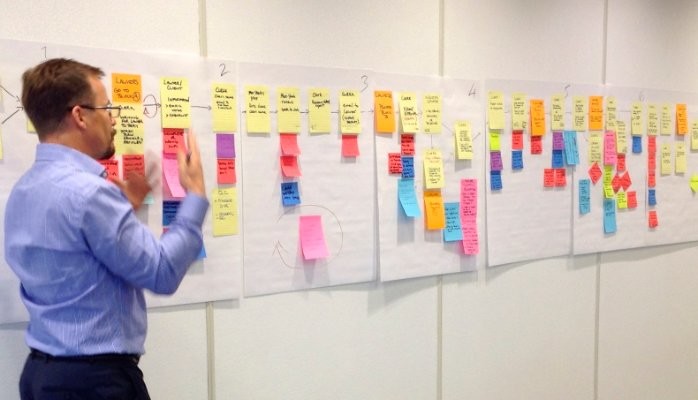
Buy-in that money can't buy: When the managing partner gets out her Sharpie
We get asked a lot about mapping software. People look at the paper-intensive way we conduct our mapping projects and think, “couldn’t we do this on a computer?”
The answer is yes. You could do it all on a computer. You could even project your screen live as you map. You’d save paper for sure…but you would lose so much more.
Improvement initiatives live or die based on buy-in.
Process mapping the old-school way, with paper and stickies, will help you get the buy-in you need. Big maps on large flip-chart sheets allow people to stand back and see, all around them, the way their process actually works. They can move tasks around, re-order things, and add additional steps, issues, or suggestions.
Seeing the process in one single visual is incredibly powerful. Even if you have the world’s best mapping software, the most people can see on a screen is a few steps at a time. They cannot see the big picture. And without the big picture, you won’t be as successful.
When we run mapping projects, we also capture the team’s improvement ideas on flip charts. We prioritize with PICK charts and Kano’s model on flip charts. We list the improvement projects the team selects, and indicate tasks, team members, and resources they might need, on flip charts. We cover the walls with them. (Aside: we like 3M’s large, self-adhesive flip charts. They stick to everything and damage nothing. We wish we’d bought shares in 3M when we started Gimbal…)
When we’re finished, the team stands surrounded by their frustrations, their current state map, their future state map, and their improvement projects.
It’s an impressive sight. It fills the room. It conveys, in a single panorama, the amount of work the team has put in, the really big picture, the details, and the plan for the future.
At this point, we bring in the project champion and members of the firm’s senior management. Usually, that’s a group including senior managers, senior partners, practice group leaders, the firm’s managing partner, and the chief executive officer. They walk into a room (often their largest boardroom) and see the walls covered in ideas. They see the project team—their partners, colleagues, and employees— collaborating to make the firm better, stronger, more profitable. No computer screen can convey that.
Then, team members make a presentation. They run through everything they’ve worked on, starting with the initial frustrations, through the current and future state maps, right up to the projects and solutions they propose to get them to their ideal future state. Whether the team is composed of partners, business or administrative people, or paralegals, they, not we, are responsible for this presentation. After all, it’s their baby.
Here’s where the old-school paper approach really shines.
Team members can stand in front of their current state map and point out problems, then move over to their future state map and show management how they propose to solve those problems. They own the solutions. They’re committed to change and they’re excited by it.
The project champions and senior management can see the current state and the future state at the same time.They can see the issues—often beyond what they realized—and the value of the creative solutions proposed by their team.
The result is magic.
In one recent project, before the presentation was even finished, the Managing Partner grabbed a Sharpie. She jumped up and began signing off on team suggestions as they were presented, approving the “just-do-it” solutions and giving the team authorization to start work on the longer projects. For the team (in this case mostly junior employees), the impact of that instant approval created a level of excitement about project improvement that money could not buy. One senior paralegal, who’d been at the firm for almost 15 years, told us afterwards that he’d never been as excited and energized.
So when people ask us about mapping software, here’s what we say: by all means, put your final, optimized map into digital form (we’ve found a great product for this - stay tuned for an upcoming post). Turn it into a practice guide you can use to standardize your work and train new lawyers, paralegals, and other employees. But start with markers, flip charts, stickies, and a blank wall. You will not be disappointed.
Want to learn more about energizing your teams and generating buy-in for your improvement initiatives? Contact us directly, subscribe to our blog, and follow us on Twitter and Facebook.
This post appeared originally on our blog, The Lean Law Firm.
All images © Gimbal Canada Inc., 2016. All rights reserved. May not be reproduced without express permission of Gimbal Canada Inc.
